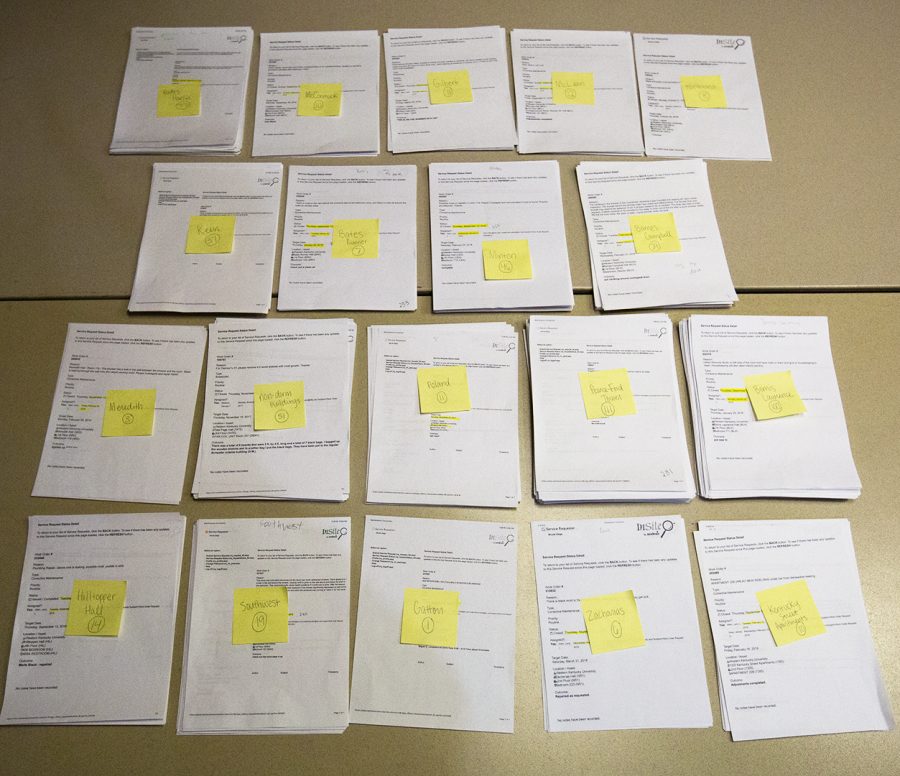More than 500 mold reports on campus in past year
November 13, 2018
It’s in every dorm, even Hilltopper Hall. It can grow quickly and spread even faster. If left untreated, it can make you sick. It grows in vents, on ceilings and on clothing and furniture.
In the past year, according to an analysis by the College Heights Herald of maintenance requests, there have been 524 reports of mold in WKU buildings — 473 in dorms.
Following the university’s announcement on Nov. 7 that it would relocate all 348 students living in Minton Hall for the remainder of the semester to combat mold, the Herald combed through more than 2,700 available web pages of maintenance requests, with 10 requests per page, for all buildings on campus to find out how widespread and how far back WKU’s mold problem had grown.
The analysis of InSite — the maintenance request database portal available to students, faculty and staff at WKU — showed the first request mentioning mold in the period analyzed was on Nov. 17, 2017. The latest reports were made as recently as Monday: four requests to remove mold in four different dorms.
Over the five-day period during which the Herald searched through InSite, the total number of pages of requests fluctuated between 2,752 and 2,731. Multiple phone calls to Housing and Residence Life officials were either not returned or referred to media relations director Bob Skipper, who did not respond to inquiries before the print deadline.
On Friday, Skipper said HRL recently switched from a paper system to the digital format. Skipper didn’t know of an exact date or reason for the switch.
More than 8 percent of requests from the period analyzed were marked as “completed” or “closed” on Sept. 13, 2018, some of which dated back to 2017. The first request found in the period on Nov. 17, 2017 was one of the 45 requests that was given a completed or closed status on Sept. 13.
On Sept. 11, freshman Adriana Qehaja tweeted directly to President Timothy Caboni a video and photos of her HVAC unit coated in mold inside Bemis Lawrence Hall. On Sept. 17, the Herald reported on Qehaja’s complaints of mold, which she said led to multiple throat illness diagnoses and high medical costs. Of the 100 mold-related maintenance requests from Bemis, 22 were resolved with a completed or closed status on Sept. 13.
Additionally, the Herald compiled a list of the physical location of mold in each report and organized them and their specifics by building.
The dorm with the most reports was Pearce-Ford Tower with a total of 111 maintenance requests reporting mold as of Monday, Nov. 12. Bemis Lawrence Hall had the second-most with 100, followed by Minton with 46.
Hilltopper Hall, which opened in August, had 14 reports of mold. Ten of the reports mentioned mold in bathrooms above the sink.
In the reports, there were more than 280 mentions of mold on or inside air conditioning units or vents, which was the most common area of reported mold.
Furniture, including chairs and mattresses in dorms, was the next most common area affected with 71 reports of mold.
Exposure to moldy environments can cause an array of negative health effects both long and short-term, according to the Center for Disease Control and Prevention. People with mold allergies can have more severe symptoms and more serious, long-term effects can include chronic lung illnesses and asthma.
The relocation of Minton Hall residents is not the first time individual students and faculty have been moved out of their dorms or classrooms because of an intense mold outbreak.
The Herald reported in 2015 that faculty members were being relocated from Helm Library, Tate Page Hall, Cherry Hall and Jones-Jaggers Hall. In the same year, mass amounts of mold were discovered in PFT after a student tweeted at HRL.
A 2002 Herald editorial urged the university to “come clean” about the mold issue. The 2002 Herald staff submitted an open records request asking for information relating to mold on campus, specifically if faculty had been moved due to mold and other accommodations made to those impacted.
The university responded and said it had no records or knowledge of faculty being moved to other buildings because of mold. The Herald had discovered specific faculty members who had been relocated due to health issues with mold, according to the article.
Sixteen years later, WKU’s mold problem continues.
News Editor Rebekah Alvey can be reached at 270-745-6011 and [email protected].
Editor-in-Chief Evan Heichelbech can be reached at 270-745-6011 and [email protected].
The following people contributed to the research and analysis for this story: Emma Austin, Emily DeLetter, Matt Stahl, Jeremy Chisenhall, Jack Dobbs, Mason Davis, Laurel Deppen, Nicole Ziege, Ellie Allen, Kelly Holland and Abbey Nutter.













